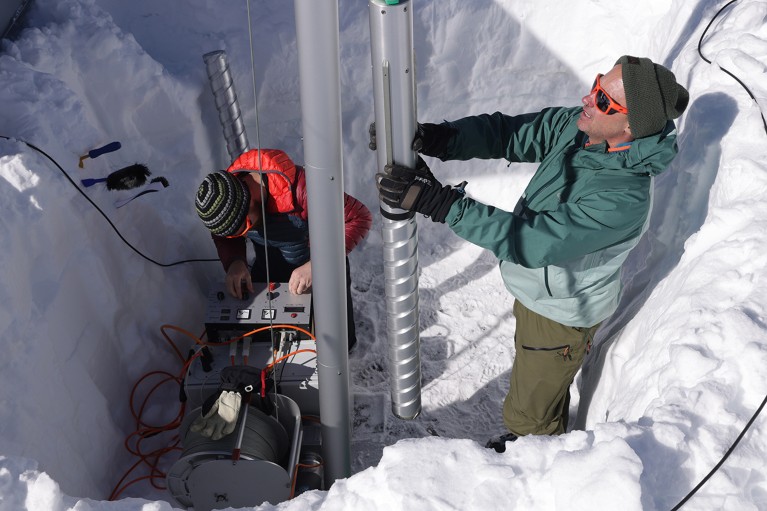Hello Nature readers, would you like to get this Briefing in your inbox free every day? Sign up here.
High temperatures seem to disrupt bumblebees’ ability to smell, a sense they rely on to feed and pollinate. Exposing the antennae of two species of bumblebee (Bombus pascuorum and Bombus terrestris) to 40 oC heat for just 3 hours made them significantly less responsive to scent molecules, a change that persisted a day later. “The results are pretty clear: There is an effect of heat waves on bumblebee physiology,” says ecologist Coline Jaworski.
Science | 5 min read
Reference: Royal Society paper
A vaccination programme to protect children in Gaza from polio started on Sunday after Israel and Hamas agreed to eight-hour daily pauses in fighting. The region has reported its first case of the disease in 25 years, in a 10-month-old baby who is now paralyzed in one leg. “This is a first step,” says UNICEF spokesperson Ammar Ammar. “But there is no alternative to a cease-fire because it’s not only polio that threatens children in Gaza, but also other factors, including malnutrition and the inhuman conditions they are living in.”
Associated Press | 4 min read
Four billion years ago, Jupiter’s moon Ganymede might have been permanently turned by an asteroid 20 times bigger than the one that killed the dinosaurs. Researchers analysed distinctive furrows on the moon’s surface that point almost directly away from the gas giant. The furrows could be the remnants of a crater formed by an asteroid that was around 300 kilometres wide, say scientists. The impact might have turned Ganymede’s face away from Jupiter and reoriented its former far side towards the planet. The Jupiter Icy Moons Explorer (JUICE) probe, currently making a daring journey to Jupiter’s moons, “will provide excellent new constraints on this ‘impact and reorientation’ hypothesis”, says planetary scientist Leigh Fletcher.
The Guardian | 4 min read
Read more: Jupiter mission will attempt first-ever fly-by that harnesses Earth and Moon’s gravity (Nature | 4 min read)
Reference: Scientific Reports paper
Features & opinion
Table of Contents
Antiretroviral therapy has saved and changed lives by preventing the HIV virus from replicating inside the body. And there are a handful of people who have been cured with disease-resistant stem-cells, as part of a painful and risky bone-marrow transplant that they needed anyway to treat cancer. But scientists are on the hunt for more long-term, scalable solutions. These include gene therapies that prevent the virus from entering cells or target the virus itself. Other efforts try to control or eliminate the latent pool of HIV-infected cells that do not produce viral particles. And some injectable antivirals approved as long-acting HIV treatments have also proved to be effective at preventing infection. The field is also making steady progress towards a vaccine, but there’s still a long way to go.
Nature | 5 min read
In the latest Nature Careers advice column, a paediatrician in South Africa wants to publish an article on medicine in resource-limited settings so that it’s free to read for the health-care workers and researchers who need it most. But the US$1,000 open-access fee is standing in the researcher’s way — a problem that disproportionately affects authors in low- and middle-income countries. Three scientists share their tips on making article processing charges more manageable.
Nature | 6 min read
Do you have a work dilemma you’d like some help with? E-mail naturecareerseditor@nature.com
From their slow migration into what we thought were inhospitable habitats to escape the effects of climate change, to one wildlife photographer’s view from the branches, here are five of the best books about our strong and silent friends, if you fancy leafing through a new one.
The Guardian | 3 min read
Where I work

Bernd Seiser is a technician at the Austrian Academy of Sciences in Innsbruck.Credit: Sean Gallup/Getty
Scientific technician and meteorologist Bernd Seiser samples ice cores to track changes in the climate of Europe’s mountains. “The sun is shining in this picture, but this isn’t your typical summer’s day — we’re on the summit of the Weißseespitze mountain in Kaunertal, Austria, 3,500 metres above sea level, and it’s −5 °C,” he says. “I often work in temperatures as low as −18 °C, fixing small parts of equipment, so sometimes I can’t wear gloves. It takes a certain type of person to do this: you have to be able to focus when you’re very cold.” (Nature | 3 min read) (Sean Gallup/Getty)
